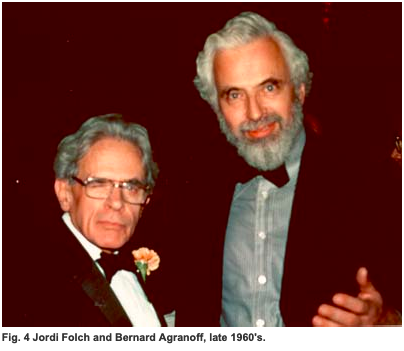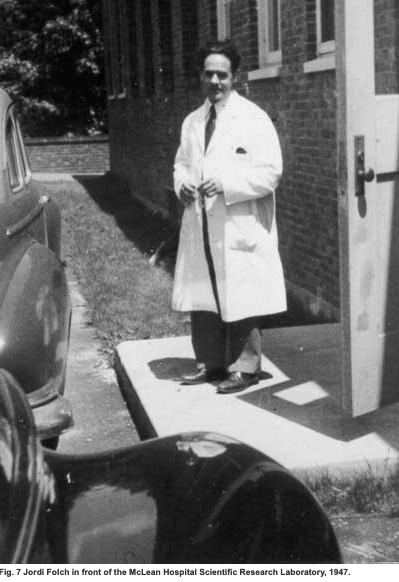An anecdotal historic look at ASN founder Jordi Folch Pi and the award bearing his name by Marjorie B. Lees |
- Home
- About The ASN
- History
- Oral History Jordi Folch Pi
C.F.B.: The ASN has been blessed right from the beginning with an unusually colorful individual at its head. Marjorie Lees is going to tell some stories about Jordi Folch Pi that many of us probably do not know.
An anecdotal historic look at ASN founder Jordi Folch Pi and the award bearing his name by Marjorie B. Lees
Claude told me that this was supposed to be an "intimate" portrait of Jordi, so I managed to get several photographs from Dr. Willa Folch-Pi, Jordi s widow,. These pictures cover a time period of almost 50 years. To begin, what could be more intimate than a bathing suit? Fig. 1 shows Jordi in 1931 at the age of 20 at a beach north of Barcelona.

This was "state of the art" fashion for its day and Willa's emphasis on the fact that it was a wool bathing suit suggests something very special and very expensive. By way of contrast, Fig. 2 is a formal studio portrait of Jordi one year later at the age of 21.
You can compare that with the much later portrait shown in Fig. 3 . Another "formal" photo shows Jordi in a black-tie during a special occasion in the 60's (Fig. 4 ).

To get back to Jordi at leisure, mountain climbing was an early passion of his, and Jordi Folch and Jordi Casals went climbing together in the Teton mountains in Wyoming (Fig. 5). The problem is that no one has been able to tell me who is who. After all, it's rear ends that we are looking at.
The photo goes back to the days when Folch and Casals were both at the Rockefeller Institute and the two Jordis were very close friends and collaborators. Casals is in his 90's now and is still very much alive and active. I spoke to him recently, after tracking him down to Mt Sinai Hospital where he still spends time interacting with students and keeping up with the scientific literature. He is intellectually sharp and sent me a lovely letter with some interesting recollections of Jordi Folch's activities at the Rockefeller Institute.

The next photograph is Jordi and Willa's wedding picture in June 1945 (Fig. 6). They appear to be sharing a martini glass---Jordi was very, very fond of martinis and insisted on having one before dinner. However, on closer examination, they appear to have compromised on wine for their wedding.
|
|
The next topic concerns a bit of early ASN history and Jordi's role in it. His role can best be summarized by a quote from Donald Tower's article in the Journal of Neurochemistry on the History of the ASN (1). To quote Don: "If any one person were to be credited with having conceived, created and nurtured the ASN, it would be Jordi Folch." This statement is not meant to take anything away from the many people in this room who also had important roles. My main recollection is that for several years there were two secretaries at McLean who did nothing but make membership lists, type them, cut them out, paste them together, retype them, etc., etc., etc.. It is the kind of thing that we now do simply by touching the" alphabetize" key on the computer.
When Jordi was Secretary and responsible for the ASN Minutes, the Council and Business meetings were not recorded on tape. Claude Baxter was the one who introduced the tape recorder. One might have assumed that the Minutes were written shortly after each meeting. I assure you that never happened during Jordi s tenure! Rather, the modus operandi would be that a year later, just before the next meeting, Jordi would hastily be writing the previous year's Minutes. What they contained depended totally on Jordi's fabulous memory. However, many details were omitted, especially if the topic did not please Jordi. At the first Council meeting that I attended as a guest, I was impressed by the valiant attempts of Lou Sokoloff and Don Tower to get a word in edgewise. They rightly felt that somebody besides Jordi should have the opportunity to express their opinions. But Jordi didn't follow Robert's Rules. The fact of the matter was that Jordi just didn't believe in Robert's Rules. To handle the potentially chaotic situation, the Council appointed Cara-Lynne Schengrund as parliamentarian. Her tact and diplomacy, along with her knowledge of the Rules, ensured that future Council and Business meetings were on track.
I have been struck by the fact that the ASN, the ISN and the Society for Neuroscience each give 1969 as the year of their founding. The expanding activity in different aspects of the neurosciences made it an appropriate time for these Societies to be founded, but they didn't just spring out of nowhere. Many years of preparation preceded their formation. There were pre-ISN meetings, symposia, IBRO meetings and a Committee on Neurochemistry within the World Federation of Neurology. Jordi had a role in each of these and his activities as scientific statesman have been documented (1-3). One point which I don't think has ever been noted in print is that the origins of all of these societies can be traced to 1949-1950 when Francis O. Schmitt organized a series of bi-monthly neuroscience-oriented seminars at MIT. The McLean scientists traipsed down to MIT for some stimulating presentations and discussions. Most of the speakers were from the Boston area. However, one evening there was an outside speaker whom I remember very distinctly. It was Paul Weiss and he introduced a very new concept called axoplasmic flow. Weiss gave an interesting and clear talk with considerable supporting data. There were questions and discussion afterwards and finally Jordi got up and said, "Thank God! What do you think the nervous system is, a plumbing system?" I was not intimidated by Jordi, but, as the axoplasmic flow field expanded, I never had the courage to confront him with that statement.
An additional topic that I have been asked to cover concerns the origins of the Folch Award. At the time of Jordi's death in 1979, Abel Lajtha was the ASN president and he suggested to the Council that the Society should do something to perpetuate Jordi s memory. The Council extensively discussed what should be done. Some members felt that we should express our feelings as individuals but not as a Society since the latter would set a precedent. Thus, as each important ASN member or founder died, we would be committed to a comparable type of recognition. The discussion got a bit heated but it was finally decided in principle that there should be an annual Jordi Folch award for a young investigator. To stop further wrangling, Abel appointed Lou Sokoloff, Francis LeBaron and myself to chair a committee to come up with the details of how the awardee should be selected. The committee developed criteria which were unanimously approved by the Council: because of Jordi's interest in worldwide science and his international connections, it was proposed to give the award for professional, foreign travel to an outstanding young investigator who had demonstrated a high level of research competence and originality. It was specifically stated that the award was for someone who was independent, had significantly advanced knowledge in the field of neurochemistry and showed a high degree of potential for future accomplishments. An additional requirement was that the awardee had to be a resident of the Western Hemisphere. However, the item that immediately became a sticky point was the definition of "young". Initially the recipient had to be under the age of forty. Later committees had a slightly different interpretation of "young" and stated "within ten years after the awarding of their final higher degree" and that is the definition which has remained.
Fund raising letters were sent to all members of the ASN, to select members of the ISN and to Jordi's friends and family. Jordi had died in October 1979 and by June 1981 more than $10,000 had been raised. Since 1982 yearly awards of $1,500 have been presented in Jordi's memory. The current (March 2000) balance in the Folch Award Fund is $36,000.1 was somewhat surprised by the relatively limited response from ISN members. I subsequently learned that they had felt slighted because neuroscientists from countries outside the Western Hemisphere were not eligible for the award. I must confess that the feelings of ISN members had not been considered or even discussed when the criteria were initially developed. The first Jordi Folch -Pi Memorial Award was given to Gary Gibson who was selected from a field of 22 applicants There is a very nice thank you letter from Gary in my files and that will go into the ASN archives. Subsequent winners have been Robert DeLorenzo, Bruce Trapp, James Gusella, Oscar Bizzozero, Charles Nemeroff, Scott Brady, Wendy Macklin, Eric Nestler, Earl DeSousa, Cheryl Craft, Brian Popko, Randy McKinnon, Daniel Kaufman, Mark Mattson, Peter Baas, Regina Murphy, Eric Murphy, Mark Smith and Kelsey Martin.
Over the years, no further changes have been made in the criteria for the award, but there have been changes in the presentations to the awardees. Somewhere along the line- I'm not sure of the date - it was decided to give each awardee a certificate that he or she could hang on a wall. The first ten or more recipients of the award probably knew Jordi personally. Later ones may have heard of Jordi, but they certainly didn't know him personally or know what he accomplished. Therefore, for the past several years the awardees have been presented with Jordi's picture and a brief biography. To encourage awardees to become involved in the Society he or she are now asked to organize a symposium for the subsequent year. That is all for now but I'm sure there will be more Jordi stories at this session.
References
1. Tower, D.B. (1987) The American Society for Neurochemistry (ASN): Antecedents, founding and early years. J. Neurochem. 48, 313-326.
2. Bachelard, H. (1993) 25 years of the International Society for Neurochemistry. J. Neurochem. 61(suppl.), 5287-5307.
3. Lees, M.B. and Pope, A. (2001) Jordi Folch-Pi 1911-1979. Biographical Memoirs 79, National Academy Press, Washington, D.C.


